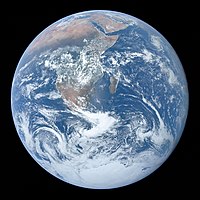
Photo from wikipedia
Urban green space has been considered as an ecological measure to mitigate urban heat islands (UHI). However, few studies investigate the cooling effect of the adjacent area of the urban… Click to show full abstract
Urban green space has been considered as an ecological measure to mitigate urban heat islands (UHI). However, few studies investigate the cooling effect of the adjacent area of the urban park; as the transition region from a green space to a hardened surface where more complex heat exchange occurs, it deserves to be paid more attention. This paper examines the relationship between the urban greening patterns and the cooling effect in the surrounding areas of the Olympic Forest Park in Beijing. Results showed that the forestland and waterbodies could cool 6.51% and 12.82% of the impervious surface temperatures, respectively. For every 10% increase in the green space ratio, the land surface temperature drops by 0.4°C, and per kilometer increase in the distance from the forest park, the land surface temperature increases by 0.15 °C. The aggregation index (AI) and largest patch index (LPI) of the green space patterns presented a strong negative correlation with surface temperature. This study confirms the cooling effects in the adjacent area of the urban park and highlights their dependence on urban greening patterns. Therefore, we should not only develop more green spaces but also scientifically plan their spatial configuration in the limited urban land for the improvement of the cooling effect.
Journal Title: Sustainability
Year Published: 2019
Link to full text (if available)
Share on Social Media: Sign Up to like & get
recommendations!